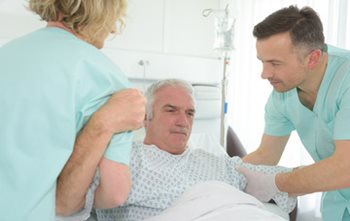
Safe Patient Handling - Preventing Patient Falls and Nursing Injuries
(*) The term ‘patient’ refers to both individuals in acute care and long-term care facilities.
(+) All references made to ‘nursing, nurses or nurse’ also includes certified nursing assistants.
Questions? Check out our FAQs page and How Online IV Certification Works!
Objectives
Upon completion of this course, participants will be able to:
- Nursing and patient factors contributing to unsafe handling tasks.
- Extent and type of injuries related to patient handling activities.
- Myths associated with safe patient handling (SPH).
- Clinical steps in determining SPH needs.
- Patient fall/and mobility risk factors and assessment/intervention associated with SPH activities.
- Organization components of a SPH program.
- Key components of a successful SPH program.
- Key components of a successful SPH program.
- Care of bariatric patients related to SPH activities.
- Benefits of SPH programs.
Curriculum
Chapter 1: Introduction
Chapter 2: SPH - Assessing Handling Risks
Chapter 3: SPH - Assessing Mobility and Fall Risk
Chapter 4: SPH - Care Planning
Chapter 5: SPH and Bariatric Care
Chapter 6: Organizing a SPH Program
Chapter 7: Key Components of a Successful SPH Program
Chapter 8: Case Study
Chapter 9: Conclusion
- References
- Appendix: SPH Beliefs vs. Facts
Price: $24.00
Contact Hours: 2

Course Author

Rein Tideiksaar
Rein Tideiksaar, PhD, PA-C, or Dr. Rein as he is commonly referred to, is the president of Fall Prevent, LLC, Blackwood, New Jersey, a consulting company that provides educational, legal, and marketing services related to fall prevention in the elderly.
Dr. Tideiksaar is a gerontologist, which is a health care professional who specializes in working with elderly patients, and a geriatric physician's assistant. He has been active in the area of fall prevention for over thirty years.
Course Accreditation
See our Accreditation Statements page to view our accreditation information.